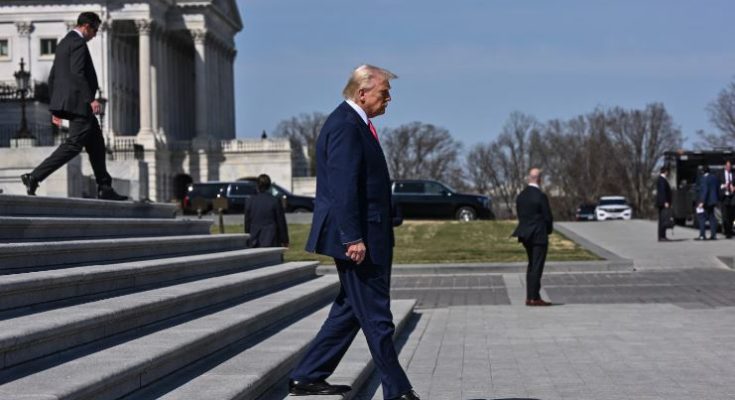President Donald Trump acknowledges that his economic plan is causing short-term pain while the nation advances to a new “Golden Age.” But administration officials have been much less clear about what that destination will look like — and how long it will take to get there.
The president talks about reindustrializing the Midwest while his treasury secretary emphasizes weaning Americans from an unhealthy reliance on government spending. Trump’s commerce secretary is keen to balance the federal budget. His top White House economic adviser touts the virtues of tax cuts and “massive deregulation.”
Amid signs of investor unease, the Trump administration insists it aims to help Main Street, not Wall Street. But so far, the administration’s discordant chorus is not satisfying either one. The erratic pace and tone of Trump 2.0 is taking a toll on the stable economy the president inherited, denting growth prospects and leaving Americans more downbeat than they have been in years.
On Friday, a closely watched consumer confidence index sank to its lowest level since November 2022, when inflation was near a 40-year high. The stock market, meanwhile, is losing altitude, as investors fear that the president means what he says about using tariffs to reverse decades of globalization.
“It is a bit of a muddle right now, what they mean. Each of the economic spokespeople speaks in different ways. And I’m not even saying they’re speaking in different ways about the same thing. They’re just speaking about different things,” said economist Glenn Hubbard, who was President George W. Bush’s top economic adviser. “It’s unsettling.”
Trump’s voice, of course, is the loudest and most authoritative. The president describes his objectives using a salesman’s best-case superlatives. His economic plan will produce “the highest quality of life” and make the country “the wealthiest and healthiest” of any in the world, he told Congress this month.
Trump has left it to his aides, particularly Treasury Secretary Scott Bessent, to articulate a more complete description of his economic overhaul. In a New York speech this month, the former hedge fund executive said the administration would spur the economy by easing regulations on banks and crafting a new approach to trade and defense burden-sharing.
Stephen Miran, the chairman of the council of economic advisers, likewise wrote late last year that Trump’s second term offered the “potential for sweeping change in the international economic system” through innovative trade and currency policies.
If the administration’s plan succeeds, the $30 trillion U.S. economy would be remade. Already less dependent on the outside world than most major nations, the United States would become even more self-sufficient, producing more of its energy, lumber, steel and computer chips than ever before.
Manufacturing would supplant financialization, creating millions of blue-collar jobs. And government spending, which now accounts for more than one-third of the economy, would shrink, perhaps to the 2000 level of 29 percent of GDP.
“This is a whole new way of thinking. It’s a new economic model,” said Stephen K. Bannon, Trump’s former chief White House strategist.
The president’s radical remaking of the economy addresses real problems: a chronically unbalanced global trading system and unsustainable government finances.
The Chinese government’s policy of subsidizing exports and discouraging consumer spending has flooded global markets with inexpensive products and contributed to a record U.S. trade deficit of more than $1.2 trillion.
At the same time, the Biden administration’s spending on pandemic relief and ambitious industrial policies left the government with an unusually large annual budget deficit of $1.8 trillion — or more than 6 percent of gross domestic product.
Debt held by the public, meanwhile, has soared to $29 trillion, or nearly 100 percent of GDP. Relative to the size of the economy, the government’s accumulated financial obligations are on track to surpass their historic high at the end of World War II.
Trump’s proposed remedies to the economy’s ailments, especially the most widespread use of tariffs in nearly a century, are audacious and, some economists say, unrealistic. Policy execution has been uneven, with the president announcing and reversing tariffs within a single day.
It’s also not clear how tariffs can simultaneously achieve multiple goals, including discouraging the purchase of foreign products, reshoring manufacturing, coercing foreign governments and raising revenue to offset the cost of Trump’s proposed tax cuts. Equally unclear: how the budget gap can be narrowed while taxes are cut.
“What are they trying to do? They don’t have a strategy. They don’t have a clear goal for these policies,” said economist Michael Strain of the American Enterprise Institute, a right-of-center think tank in Washington. “I think what we’re seeing is incompetence.”
On Wednesday, High Frequency Economics, an economic analysis firm, headlined its daily research email: “Global financial markets brace for another day of chaos from Washington.”
After often citing stock market results to validate his first-term performance, Trump and his team now wave off market worries. “The real economy,” not Wall Street, is the administration’s focus, Bessent told CNBC on Thursday.



